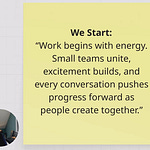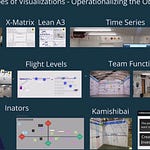Strategy Course on Modus Institute | Karl and Jim Live Workshop in Bristol Nov 2025
Work sucks, work is wonderful.
We’ve been thinking about strategy lately. Not the retreat-in-Cancún kind where executives disappear for a weekend and return with glossy presentations nobody asked for way. The collaborative way. The effective way. Strategy created by the messy, collaborative, utterly human process of figuring out where we’re going and why that matters. The effective way.
While creating the second course in the Strategy and X-Matrix course, we (Karl Scotland and Jim Benson) had a conversation about three deceptively simple, profound approaches to strategy. Strategy historically has been a dictate, something you can put on a card and carry around with you. But if we treat it like an action … I am acting strategically … this means we have to be aware of our future desires, our past behaviors, and our current reality. And we have the acts of forecasting, backcasting, and sidecasting.
We have three different ways of understanding how we relate to uncertainty, how we learn from the past, and how we stay grounded in present reality while still moving toward something better. This post introduces these three concepts.
We’ll be diving deeper into each approach in future posts and exploring them in more detail in an upcoming workshop. For now, let’s just introduce them.
Forecasting is Seductive Wishing
Forecasting feels safe. Organizations and managers love forecasting because it creates an illusion of control. “We know what our operating model should look like,” they say. “We’ll just create our goals, follow our playbook, and get there.”
Forecasting actually feels pretty good in the moment. It’s the strategic equivalent of drawing a straight line from here to there and calling it a plan. Over the years, we’ve seen this play out repeatedly: organizations become attached to a given and brittle solution, believing it can be achieved without adaptation.
Forecasting assumes a level of predictability that simply doesn’t exist in complex systems. A forecast is a plan, and plans do not survive contact with reality unscathed; there are always changes, learning, and new directions. Organizations that over-attach to forecasting miss something crucial: to adequately forecast, you have to understand the work you need to do, the team you have to do it with, and the rate of variation in the market of whatever you’re creating. These elements are dynamic, contextual, and deeply human. Successful forecasting only happens when the forecast comes with the ability to change, be updated, and continuously re-forecast based on the best available data.
Backcasting is Scientific Fantasy
Backcasting sounds more sophisticated. Instead of just projecting forward, you start with your desired future state and work backward to figure out what needs to happen. It feels more thoughtful, more strategic.
Backcasting has its own challenges, though. When you’re working backward from that perfect future state (an overly specific goal), you’re often working backward from a fantasy. You’re assuming that your desired endpoint is actually achievable with your current culture, skills, and organizational reality.
Too many organizations create beautiful backcasting exercises that ignore their starting point and undervalue changes along the way. They design the perfect process, work backward to create the perfect implementation plan, and then wonder why it feels like they’re trying to implement someone else’s solution in their own context. The missing piece? Understanding where you actually are right now.
Sidecasting Just Might Have Some Strategic Presence
This is where sidecasting makes things interesting.
Sidecasting, a term coined by Dave Snowden, focuses on now. Now, to the best of our understanding, is real. Real is good.
In sidecasting, you look at the data you have, the visual information available to you, and use that to figure out just what to do next. It is strategy as situational awareness. It is strategy always updated to match what is both desirable and achievable.
Karl described his most enjoyable change efforts as the ones where teams just started trying stuff. “What new practice might we try?” became the driving question. No grand implementation plan, no perfect future state—just careful experimentation in context.
This reminds us of Kevin Chase at Turner Construction, whom Jim wrote about in The Collaboration Equation. Kevin told him, “I work in construction. Nothing is going to impact my work/life balance. But the Kanban here in this room helps me communicate with my bosses, their bosses, and my team. They know what’s going on, and that helps me act with confidence.”
That’s sidecasting in action. Kevin wasn’t implementing a methodology or working toward some idealized future state. He was solving a real problem, a lack of confidence that came from communication difficulties, with the tools and context available to him. His right now, made visual, allowed him to act both tactically and strategically.
You Can’t Have One Without the Other
The most effective strategic approaches we’ve seen don’t choose between forecasting, backcasting, and sidecasting. They dance between all three.
Memento Vivere: They forecast enough to understand direction and intent. This provides shared understanding of where we think we’re heading and why that matters. What might a good end-state look like? They set direction.
Memento Mori: They backcast enough to create initial hypotheses based on experience. What has happened to us previously? How does that inform how we’ll approach this next group of work? This honors the wisdom embedded in our collective experience and uses our experience and experiments to update and adjust our forecasts.
Carpe Diem: And they sidecast constantly to stay grounded in current reality. What are we doing right now? What’s actually happening on the ground? What does the data tell us about how things are flowing? How should we adjust and adapt our approach? What opportunities are presenting themselves?
When you visualize all three of these perspectives in real time, something magical happens. People can see their work clearly enough to make good decisions about what to focus on, what to delegate, and what to decline.
Making Strategy Visible and Human
Think about the construction site where teams track corporate performance metrics daily, not because some consultant told them to, but because they can see how their daily work connects to larger outcomes.
This is what happens when forecasting, backcasting, and sidecasting work together. Strategy becomes something people participate in rather than something they receive. The forecast informs direction, the backcast utilises learning, and the sidecast provides agency. And this is all best done visually.
The real breakthrough comes from creating systems that help humans navigate uncertainty together.
After twenty years of watching people try to get work done, we know this: we’re all making it up as we go along. The question isn’t whether you have the perfect strategy. The question is whether your approach to strategy helps people act with confidence in the face of uncertainty.
And that requires all three: enough vision to move forward, enough reflection to learn from experience, and enough presence to respond to what’s actually happening right now.
The best strategies aren’t perfect plans—they’re learning systems that adapt as quickly as the humans who use them.
Events with Karl and Jim:
This conversation emerged from ongoing work on making strategy deployment more collaborative and humane. We’ll be exploring these concepts in more detail in future posts, as well as these events:
Our Visual Leadership workshop LIVE in Bristol in Nov 2025,
Our online Strategic Aspirations Workshop
Our online Creating Strategy Workshop
Our online Strategy and Tactics Workshop
Our online Strategic Evidence (Metrics and ROI for Strategy) Workshop
and in an upcoming workshop focused specifically on the art of casting.
If you’re interested in exploring these ideas with your team, we’d love to hear from you just leave a comment or talk to us on linkedin Jim LinkedIn … Karl LinkedIn.











